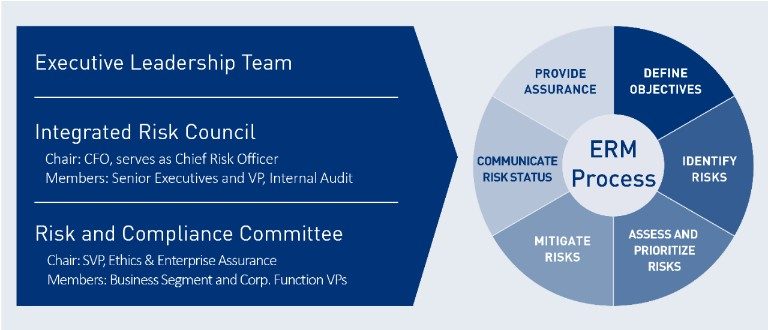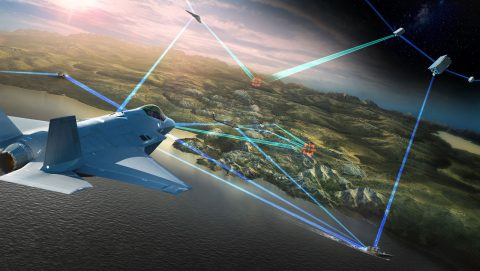Sustainability Governance
The Lockheed Martin sustainability governance structure is composed of the Nominating and Corporate Governance Committee of the Board of Directors, the Executive Leadership Team, the Risk and Compliance Committee (RCC) and the Sustainability Management Team.
Our senior vice president, Ethics and Enterprise Assurance, oversees all sustainability programs and serves as Lockheed Martin’s chief sustainability officer. This position reports directly to the chairman, president and chief executive officer and provides regular updates to the Nominating and Corporate Governance Committee.
We link incentive compensation for Lockheed Martin executives to performance on certain sustainability factors, such as attracting and retaining a premier workforce, protecting data from cyber intrusion, ensuring the safety of products and services, and managing the environmental impact of our business.
In addition to our general sustainability governance, Lockheed Martin has strong frameworks for the governance of key topics described below. For further information on Lockheed Martin’s stakeholder governance and the management of our sustainability priorities, please visit our Materiality Assessment or 2025 Sustainability Management Plan website.
Emissions Management
We are committed to building a strong foundation to support long-term decarbonization, with a focus on energy efficiency, renewable energy, and resilience. Lockheed Martin’s senior vice president, Ethics and Enterprise Assurance, has leadership oversight for these efforts and provides performance reporting to the Executive Leadership Team. To read more about our carbon strategy and approach to climate-related risk management, visit our Emissions Management website. To read more about our climate-related risk analysis, download our latest Climate-Related Risks and Opportunities report, which is aligned with the Task Force on Climate-related Financial Disclosures (TCFD), and our 2024 Climate Disclosures Project (CDP) Report.
Enterprise Risk Management
Management is responsible for executing the enterprise risk management (ERM) process and the day-to-day management and mitigation of risks, and the Board of Directors is ultimately responsible for Lockheed Martin’s risk oversight. Corporate executives provide the Board and its committees with reports on enterprise-wide, business area and strategic risks. Two primary components of the ERM process are an annual strategic and operational enterprise risk assessment and a biennial compliance risk assessment (CRA). Both assessments are associated with our sustainability strategy, but the latter intentionally integrates our sustainability initiatives to ensure a comprehensive approach to risk management. Approximately 800 subject matter experts across the company are surveyed on compliance risks and vulnerabilities in relation to sustainability matters. Risk owners are identified to address recommendations surfacing from the CRA. The RCC and Integrated Risk Council review the outcomes of both assessments and their accompanied recommendations for mitigation actions. Their outcomes are subsequently reported to the Audit Committee of the Board of Directors. During the last compliance assessment in 2022, the use of artificial intelligence (AI) was one of the new emerging risk topics, and steps were taken to mitigate potential risks, such as including AI ethics in our Code of Ethics and Business Conduct and the development of a “consent-to-use” training program. The latest compliance risk assessment took place in the first quarter of 2024.

Human Rights
At Lockheed Martin, we believe respect for human rights is an essential element of being a good corporate citizen and is integral to the long-term success of the company. Treating employees with respect, minimizing negative consequences of our business activities, and contributing to economic and social well-being are all key components of our Human Rights Policy and Principles. Lockheed Martin’s activities comply with the laws and regulations of the countries in which we operate, except where such laws conflict with U.S. law, and our compliance with them is reinforced by our robust integrated assurance program and board of directors’ oversight of our enterprise risk management process. Respect for human rights in our operations and supply chain is ingrained through strong policies and training to educate employees and third parties on human rights issues and risks. Our due diligence processes are embedded within our operating and decision-making practices and procedures and are supported by formal grievance mechanisms that can be used by internal and/or external parties to notify and inform us of potential misconduct. To learn more, visit our Human Rights website.
Political and Public Policy Participation
Lockheed Martin is committed to participating in the political and public policy process in a responsible and ethical way that serves the best interests of our stockholders and customers. Decisions regarding corporate political and public policy activities are managed by the senior vice president, Lockheed Martin Government Affairs, following coordination with individual Lockheed Martin elements in accordance with established policies and procedures and they are ultimately overseen by the Nominating and Corporate Governance Committee of the Board of Directors. Further information on our engagement in the legislative process and political and public policy activities, including our advocacy efforts, government affairs activities, trade association activities and political spending, is available on our Political Disclosures website. We regularly evaluate the public policy positions of selected trade and industry associations of which we are members to assess their alignment with our Sustainability policy and program. The results can be found on our Emissions Management website.


